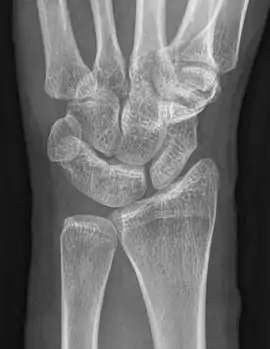Carpal coalition
| Carpal coalition | |
|---|---|
 | |
| An example of a lunotriquetral coalition, the most commonly fused carpal bones | |
| Usual onset | Congenital |
Carpal coalition is the abnormal fusion of two or more carpal bones when they fail to segment during intrauterine development.[1] First described by Eduard Sandifort in 1779, carpal coalitions are often an isolated issue which connect two carpal bones in the same row of the wrist.[2] These issues are congenital and occur at various rates throughout the population.[3]
Signs and symptoms
Patients with carpal coalition often offer no clinical significance and patients rarely have any associated issues. Though infrequent, some patients may complain of pain.[4]
Causes
Carpal coalition result from an incomplete separation of a common embryological carpal precursor in utero, during the fifth to eighth weeks.[1]
Subtypes

The lunate and triquetral bones are the most common carpal bones to fuse together, resulting in a lunotriquetral coalition in 1% of people. 60% of patients with a lunotriquetral coalition will have it bilaterally.[1] Among isolated incidents the capitate and hamate bones are the next most common to fuse followed by the pisiform-triquetrum, trapezium-trapezoid, scaphoid-capitate, and triquetrum-hamate.[3]
Carpal coalitions may further be divided into four subtypes:[3]
- Type 1 - incomplete fusion with pseudoarthrosis
- Type 2 - fusion with a "notch" between the fused bones
- Type 3 - complete fusion
- Type 4 - complete fusion with other anomalies present
Treatment
Generally since carpal-carpal fusions do not cause unease or discomfort for the patient, and do not impair wrist function, treatment is not needed. However, in the minority of cases where carpal coalition causes persistent pain, arthrodesis, or the surgical fusion of a joint, has been proven to be beneficial.[5]
Epidemiology
Carpal coalition occurs at a ratio of 2:1 in females, and are considered to have a multifactorial inheritance pattern.[3] Further, the incidence according to race varies, with a rate of 0.1% in Caucasian populations, 1.6% in African American populations, and over 8% in certain West African tribes.[2]
Associated problems
Multiple carpal coalitions, or carpal coalitions that connect the two different rows of carpal muscles, are often associated with other anomalies including:[1][3]
See also
References
- 1 2 3 4 Chew, Felix; Mulcahy, Hyojeong; Ha, Alice S. (2012). Musculoskeletal Imaging: A Teaching File. Lippincott Williams & Wilkins. pp. 41–42. ISBN 9781609137939. Retrieved 26 January 2018.
- 1 2 Jr, Donald R. Laub (2014). Congenital Anomalies of the Upper Extremity: Etiology and Management. Springer. p. 219. ISBN 9781489975041. Retrieved 26 January 2018.
- 1 2 3 4 5 Cooney, William P. (2010). The Wrist: Diagnosis and Operative Treatment. Lippincott Williams & Wilkins. pp. 844–845. ISBN 9781608313907. Retrieved 26 January 2018.
- ↑ Chew, Felix S. (2010). Skeletal Radiology: The Bare Bones. Lippincott Williams & Wilkins. p. 260. ISBN 9781608317066. Retrieved 26 January 2018.
- ↑ Stevenson, Roger E.; Hall, Judith G.; Everman, David B.; Solomon, Benjamin D. (2015). Human Malformations and Related Anomalies. Oxford University Press. p. 63. ISBN 9780199386048. Retrieved 26 January 2018.